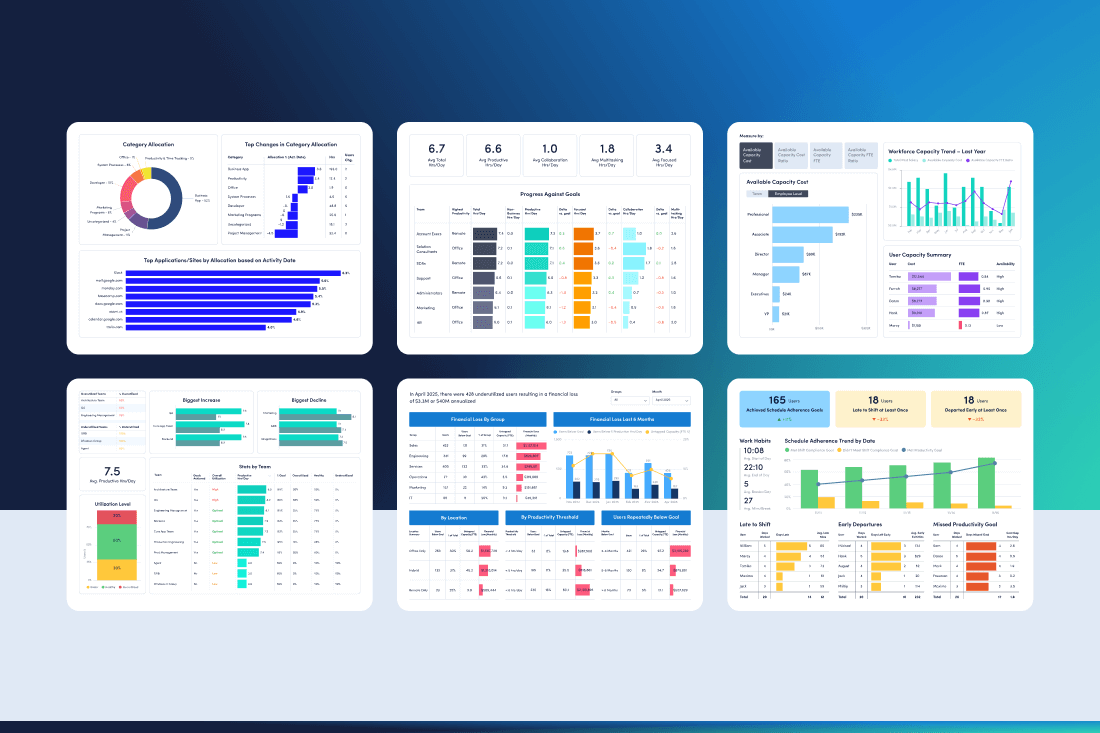With remote work now the norm, competitive organizations are adapting new ways to make the most of it. To successfully manage a remote team, you must do more than simply allow employees to work from home. You also need to keep the lines of communication open, ensure accountability and improve productivity while balancing employee well-being and engagement.
Get tips on managing remote employees to create a work environment where employee engagement, morale and productivity come together to drive success.
The importance of managing your remote workers
Your workforce is your company’s most valuable asset and you need to manage it efficiently, no matter where they work. As Gallup reports, over half of remote-capable employees work hybrid schedules, while nearly a third are exclusively remote. Flexible schedules and remote work increase productivity and employee satisfaction while reducing overhead costs and talent attrition. But managing a remote team is markedly different from managing an in-office team, and successful leaders must take an intentional, strategic approach to remote workforce management to fully reap the benefits of remote schedules.
According to research from Stanford, Americans would take a pay cut of nearly 10% in exchange for working from home a few days a week. Workers with remote schedules are also more likely to stay with their companies longer, which reduces the costs associated with turnover and rehiring. However, the same research shows managers and employees perceive remote work productivity differently. Employees who don’t have to commute to work devote an extra hour to work each week, making them feel more productive. But managers express concern about how their employees spend that difficult-to-measure extra time. To successfully manage remote employees, managers must adopt new measurement methods and work to balance employee well-being and satisfaction with productivity and performance.
How to manage a remote team: 14 effective tips
There’s no one-size-fits-all solution for managing a remote team effectively. These remote management tips, backed by research and data, are effective management guidelines for any organization.
1. Set clear expectations
Effective remote team management starts with setting clear expectations — and ensuring everyone has the resources they need to meet them. Outline everything your remote workers need to know, including expected work hours, how frequently they need to check in and proper communication channels. Your remote work policy is also a space to answer any questions about the work environment and provide easy access to helpful resources. Ensure employees understand their job responsibilities and set clear goals and KPIs to measure success.
2. Evaluate existing software to create a cohesive remote work tech stack
After enterprises make the switch to a remote environment, many find issues with their tech stack. From accessibility issues due to the bandwidth of an organization’s VPN to apps that don’t work well outside the firewall, various technical difficulties hamper remote employee productivity. To mitigate this, ensure all of your software tools are well-integrated. In addition, consider using remote workforce management software to identify and resolve software-based bottlenecks by consolidating duplicative apps, canceling unused licenses or implementing better training for employees to use apps to their full potential.
3. Invest in proper remote technology to fill gaps
Remote work technology evolves over time, and effective managers actively seek out the best tools to empower employee productivity. Why? Because virtual teams must interact as efficiently as if they were together in a physical office. Try out a few remote work tools to determine which ones help your remote teams the most. At a minimum, evaluate project management apps, virtual team meeting options and collaboration tools. Set clear expectations around using each tool to ensure they’re well-integrated into daily workflows, and revise as needed.
4. Analyze productivity to understand how work gets done
In a remote environment, it’s increasingly important to get answers on “how do you work?” instead of “are you working?”. One of the best tips for managing remote workers is to implement workplace productivity monitoring — not as a way to spy but rather to support them more effectively. Unlike check-ins and virtual meetings that only offer a surface-level understanding of the remote worker experience, a monitoring solution uses data and productivity metrics to help you understand how your remote teams are working. This empowers you to offer more targeted support as part of your remote workforce management efforts.
5. Set up regular syncs
Another easy way to promote communication in a remote setting is to schedule regular check-ins. These allow you to celebrate what’s working well and discuss what needs improvement. In a remote setting, it’s easy for managers to micromanage or check in too frequently, distracting employees from focused work. Regular syncs give managers and employees a scheduled opportunity to check on progress, ask questions or discuss non-emergent issues. These touchpoints also boost remote employee engagement and help remote workers stay productive. Just don’t overdo it. While some interaction strengthens bonds, too many team meetings hurts productivity.
6. Create channels for feedback
Even with regularly scheduled syncs, you may not see and talk to remote team members daily. This doesn’t mean you can’t learn about their needs outside of official meetings. Create an environment where people feel comfortable sharing concerns and have multiple ways to do so, including anonymously. Managers should also proactively ask employees about roadblocks, communication issues or what would make their jobs easier. And implement any suggestions right away. This not only helps you achieve goals faster, but also shows employees you care about their success.
7. Prevent cybersecurity risks
The growing volume of remote workers has expanded the security perimeter beyond what many organizations can handle effectively. According to a report by Shred-it, 47% of business leaders said human error had caused a data breach at their organization. A growing web of remote workers, contractors and third-party suppliers complicates detecting, preventing and tracking threats to customer data, company IP and even private employee data. Beyond implementing strong firewalls and VPNs, companies should monitor risky remote work behaviors that put security and sensitive data at risk. Today’s employee monitoring tools offer ways to block access to risky websites and set suspicious activity alarms to keep sensitive information safe.
8. Create a positive remote employee experience
Having a comfortable work environment is important for everyone, and remote workers need support for both physical and mental well-being to work productively. Organizations should standardize remote equipment, including laptops, WiFi hotspots and even desks and chairs to ensure employees have the tools they need to work effectively. Implementing employee engagement best practices and fostering a healthy company culture allows you to boost job satisfaction and retention by creating an environment employees want to stay in. Managers should encourage employees to work on projects that inspire them and lend their support if a remote employee wants to explore a different way they can contribute to the organization. When a company is committed to its remote employees and has a strategy that focuses on its people, it tends to provide a better overall employee experience.
9. Organize remote social events
Company culture is essential to the success of any organization. But finding opportunities for team-building and watercooler moments is challenging for remote team managers. Take steps to create hangouts and get-togethers — even if they’re virtual — to foster a sense of community and camaraderie. Something as simple as highlighting recent employee wins and milestones during video calls goes a long way in unifying remote team members. These interactions are just as essential to remote employee success as understanding their productivity.
10. Take steps to prevent overwork and burnout
Avoiding employee burnout and overwork is one of the most important — and most difficult — elements of managing remote employees. For many people, the home office effectively eliminates the divide between home life and work life, meaning work hours often bleed into personal time. Furthermore, when teams are spread across multiple time zones and geographic locations, teams often need to work longer hours to accommodate collaboration. Managers must promote a healthy work-life balance for remote workers through clear policies and by modeling healthy boundaries. They should also use workload management software to ensure work is distributed evenly and fairly, and to spot signs of burnout before they balloon into bigger problems.
11. Identify and address operational practices that cause bottlenecks
Did you know businesses can lose up to $1.3 million a year on inefficient processes? While properly managing workflows is important for all teams, it’s especially critical in remote settings. When employees rarely or never interact in person, your workflows serve as the glue to keep everyone on the same page. Offering better digital communication tools, calling out problematic behavior and developing policies to address these issues are good ways to start. Better yet, look for tools that deliver data-driven insights around productivity and operational efficiency to guide policy changes.
12. Use workforce analytics
One of the best ways to successfully manage remote workers in the new landscape is with a productivity monitoring and workforce analytics solution like ActivTrak. ActivTrak’s solutions deliver unprecedented visibility into your remote teams, empowering you to create a healthier and more productive workplace by identifying inefficient processes, unbalanced workloads and more. Instead of relying on hunches, managers leverage ActivTrak to get objective, reliable productivity insights into focus time, work hours and app usage. The software also combines a bird’s-eye view of processes with granular context to show exactly where workflows break down. Plus, ActivTrak shows you who’s at risk of burnout, even if they haven’t mentioned it, to help team managers make effective resourcing decisions and make sure nobody is overworked.
13. Recognize employee effort and achievements
When working with remote employees, a little recognition goes a long way. When employees understand how their work impacts the organization, they’re more likely to put in extra effort. Create a team recognition program to celebrate milestones and achievements on a regular basis. This could be as simple as sending a monthly “thank you” email. Or you might reward team members who go the extra mile with paid time off. Find out what matters most to your remote employees and build a program around their preferences. Workforce analytics gives managers objective insight into employee and team success, empowering them to give credit where it’s due.
14. Offer development opportunities
Professional development is one of the biggest predictors of success. It’s also key to retention — 94% of surveyed employees will stay longer at a company that invests in learning. Start by identifying skills gaps within your team and asking your employees what they’d like to learn. Then find opportunities that match your needs. Virtual training programs, on-site seminars and conferences are all strong options. It all depends on your specific team members, so gather their input before registering for any new programs. Better yet, let your employees do the research and planning. Furthermore, use workforce analytics to spot underutilized employees or training opportunities.
Challenges of managing a remote team
Although remote work offers many benefits like happier employees, reduced costs and increased retention, challenges naturally arise when it comes to managing a remote workforce. Some of the most common include:
1. Lack of collaboration and communication
Dispersed teams often struggle to adapt to remote communication, causing employees to miss important information when they don’t have the right tools or processes in place. Remote employees also report they’re often passed over for promotions because their managers don’t see their contributions equally. Managers must work to ensure employees have equitable access and understand communication policies. Going digital-first, implementing asynchronous communication and fine-tuning project management tools all contribute to better collaboration and communication.
2. New distractions
In-office work is often touted as the most distracting for employees, but working from home raises its own issues. Family members or roommates, entertainment options, childcare, pets and housework are all tempting for remote employees. Organizations should set policies and provide tools to help employees avoid distractions and maximize their focus time. This includes encouraging frequent breaks, scheduling work blocks and using tools like noise-canceling headphones.
3. Isolation and loneliness
For remote workers, loneliness leads to poor outcomes for physical and mental health as productivity. A 2020 State of Remote Work report issued by the social-media management firm Buffer showed that loneliness is tied with collaboration and communication as the biggest struggle remote workers face. Managers should plan remote interactions like virtual happy hours or open a fun chat channel to help maintain a sense of normality and bring a sense of community back. While you’re together, be sure to listen and offer encouragement and emotional support.
4. Lack of supervision
Remote employees often find it difficult to prioritize work or complete tasks when they have less access to managerial support and communication. They may also feel their supervisors are out of touch with their needs and don’t support their work. Managers should establish structured check-ins, create clear milestones with precise deadlines and use meeting time to discuss progress and obstacles. Communicate KPIs and goals clearly and invite employees to speak to their supervisors about any concerns as needed.
5. Lack of transparency
Another challenge remote managers frequently face is a lack of transparency. In an office setting, you see how employees work — if their plates are too full, if they have capacity for another project, if they arrive early or leave late. In contrast, remote employees aren’t as comfortable approaching managers to discuss heavy workloads and work-life balance issues. This often tempts managers to micromanage by checking in too often or overdirecting how work gets done. Workforce analytics mitigates this problem by providing insight into employee productivity without constantly pinging employees.
6. Compliance difficulties
It’s easy to see when in-office employees clock in and out. You also know who’s at their desks, what devices they use and which network they connect to. Not so with remote workers. It’s much more challenging to ensure compliance with your work policies — especially if you don’t use monitoring software. Furthermore, if you work in a highly regulated environment like government, finance or healthcare, you need enhanced security measures to spot and stop compliance and regulation problems before you face heavy fines or legal issues.
7. Data security threats
Every organization faces the constant threat of data breaches. But this concern is particularly challenging for remote organizations. In addition to securing corporate devices, IT must stay ahead of account takeovers, phishing attacks, unsecure Wi-Fi networks and other cybersecurity threats that put sensitive data at risk.
8. Work-life balance issues
With the virtual office mere steps away, it’s hard to unplug. Which means many remote employees struggle with setting boundaries. And unfortunately, regularly opening the laptop or checking email “just one more time” is a recipe for employee burnout. Employees need policies to set boundaries between work and personal life, and to support mental health and well-being outside of work hours.
Manage your remote team with insights from ActivTrak
There are many benefits to the new remote work landscape. But without the proper tools, it can be difficult to make the most of them. The tips outlined above are a great way to transform how your remote employees work.
Looking for more insights? Leverage ActivTrak’s remote workforce management and workforce analytics tools to better manage remote workers. Our solutions deliver the real-time insights you need to create a positive work environment where employee engagement, operational efficiency and productivity go hand-in-hand. Get started today with a free account, and get in touch to learn how companies like yours use ActivTrak to make remote teams more productive.





